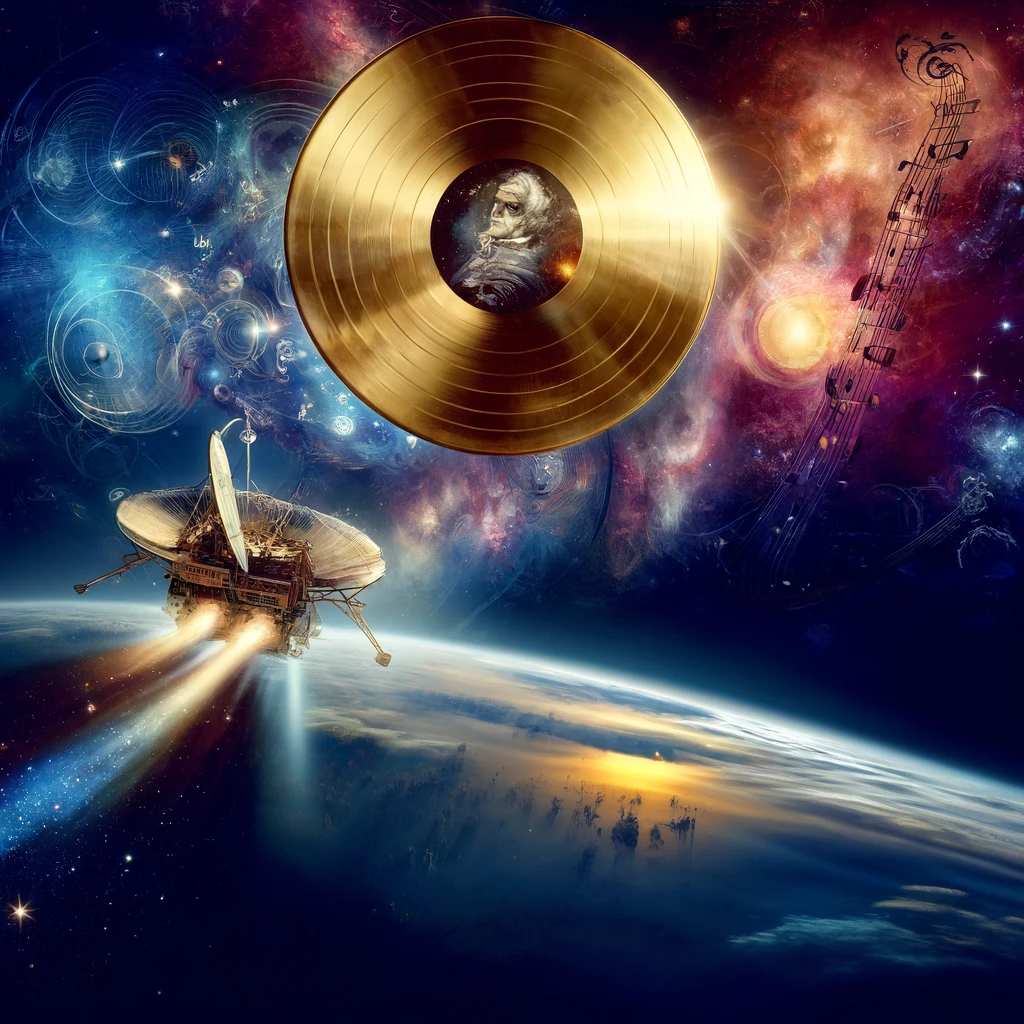
Beethoven’s Music in Space: Voyager Golden Record and Beyond
Ludwig van Beethoven, baptized on December 17, 1770, in Bonn, Germany, and passing away on March 26, 1827, in Vienna, Austria, remains one of the most revered figures in the history of Western music. His works not only form a crucial part of the classical music repertoire but also represent a bridge from the Classical period to the Romantic era. Beethoven’s life and work reflect an unyielding dedication to musical innovation and expression, despite personal adversities, including progressive deafness.
Early Life and Musical Beginnings
Born into a family of musicians, Beethoven displayed his musical talents early. His father, Johann van Beethoven, first instructed him, followed by Christian Gottlob Neefe, under whose guidance Beethoven published his first work, a set of keyboard variations. He quickly gained recognition, leading to his sponsorship by Elector Maximilian Friedrich and later by others, including Count Ferdinand von Waldstein. His early exposure to the Enlightenment ideals prevalent in Bonn would influence his musical style and philosophy.
Artistic Evolution and Innovations
Beethoven’s career is typically divided into early, middle, and late periods. His early period saw him mastering the craft, influenced by composers like Haydn and Mozart. The middle period, often characterized as heroic, was marked by his increasing deafness. Despite this, he continued to innovate, reshaping musical forms like the symphony, sonata, concerto, and quartet. Perhaps most notably, his Symphony No. 9 in D Minor broke new ground by incorporating a choral finale, a first in the history of classical music.
Global Influence and the Voyager Golden Record
Beethoven’s global influence is profound. His music has resonated through generations and geographies, influencing composers like Schumann and reshaping the musical landscape. The inclusion of his works on the Voyager Golden Record, sent into space in 1977, symbolizes this transcendent appeal. Beethoven’s music, chosen for its cultural significance and beauty, now travels beyond our planet, representing humanity in the vast expanse of space.
Beethoven’s Legacy and Beyond
Ludwig van Beethoven’s influence extends far beyond his lifetime. His compositions are not just performed and celebrated worldwide; they have also been instrumental in shaping the trajectory of Western music. His ability to convey a philosophy of life through music without a spoken text has been particularly impactful. His assertive compositions reflect the human will, bridging the gap between music and philosophy.
Ludwig van Beethoven’s life and work demonstrate an unparalleled commitment to musical evolution. His compositions, resonating across time and space, have become synonymous with human creativity and spirit. From historic stages to the Voyager Golden Record, his legacy continues to inspire and influence, making his music truly universal.

The Resonance of Beethoven’s Work in Modern Times
Ludwig van Beethoven’s music has transcended the confines of time and geography, echoing through the corridors of modern civilization. This part of the article delves deeper into the pervasive influence of his compositions in contemporary culture and beyond.
Music as a Reflection of Societal Shifts
Beethoven lived through a period of significant social and political change, epitomized by the Enlightenment and the French Revolution. His works often mirrored these shifts, intertwining musical genius with the spirit of humanism and a burgeoning sense of individualism. This alignment with the zeitgeist of his time rendered his music a timeless quality, resonating with listeners across generations.
From Classic Concert Halls to Modern Media
Beethoven’s music has found its way into various aspects of contemporary culture. His compositions frequently feature in film scores, television series, and even video games, showcasing their versatility and enduring appeal. For instance, Symphony No. 6 in F Major was notably featured in Walt Disney’s “Fantasia” (1940), demonstrating how his music transcends traditional classical music venues.
The Educational and Therapeutic Use of Beethoven’s Music
Beethoven’s works are not only performed but also used in education and therapy. Studies have suggested that his compositions, like many classical music pieces, can aid in cognitive development and stress reduction. His music is often used as a tool for relaxation and concentration, highlighting its therapeutic qualities.
Influence on Later Composers and Musicians
Beethoven’s revolutionary approach to musical composition profoundly influenced later composers. Musicians like Robert Schumann and Richard Strauss drew inspiration from Beethoven’s harmonic innovations and thematic explorations. His impact is evident in their works, showcasing the enduring influence of his musical language.
Beethoven in the Digital Age
In the age of digital music, Beethoven’s presence remains strong. Platforms like iTunes and Spotify feature his works extensively, making them accessible to a global audience. The democratization of music through digital platforms has played a significant role in keeping Beethoven’s legacy alive in the 21st century.
Conclusion
Beethoven’s influence is as vast as it is deep, extending far beyond the classical music sphere. His ability to encapsulate the human experience in his compositions makes his music timeless and universally relatable. As his works continue to be celebrated and studied, Beethoven’s legacy lives on, both in the hallowed halls of classical music and in the broader cultural landscape.
References
- “Ludwig van Beethoven | Biography, Music, & Facts,” Britannica. Source.
- “How Beethoven’s Symphonies Changed the World,” Gramophone. Source.
- “Ludwig van Beethoven | Biography, History, Music, Facts,” Classic FM. Source.
- “Ludwig van Beethoven,” Humanities LibreTexts. Source.
- “Ludwig van Beethoven,” Wikiwand. Source.
- “Symphony No. 9 in D Minor, Op. 125,” Memory of the World, UNESCO. Source.